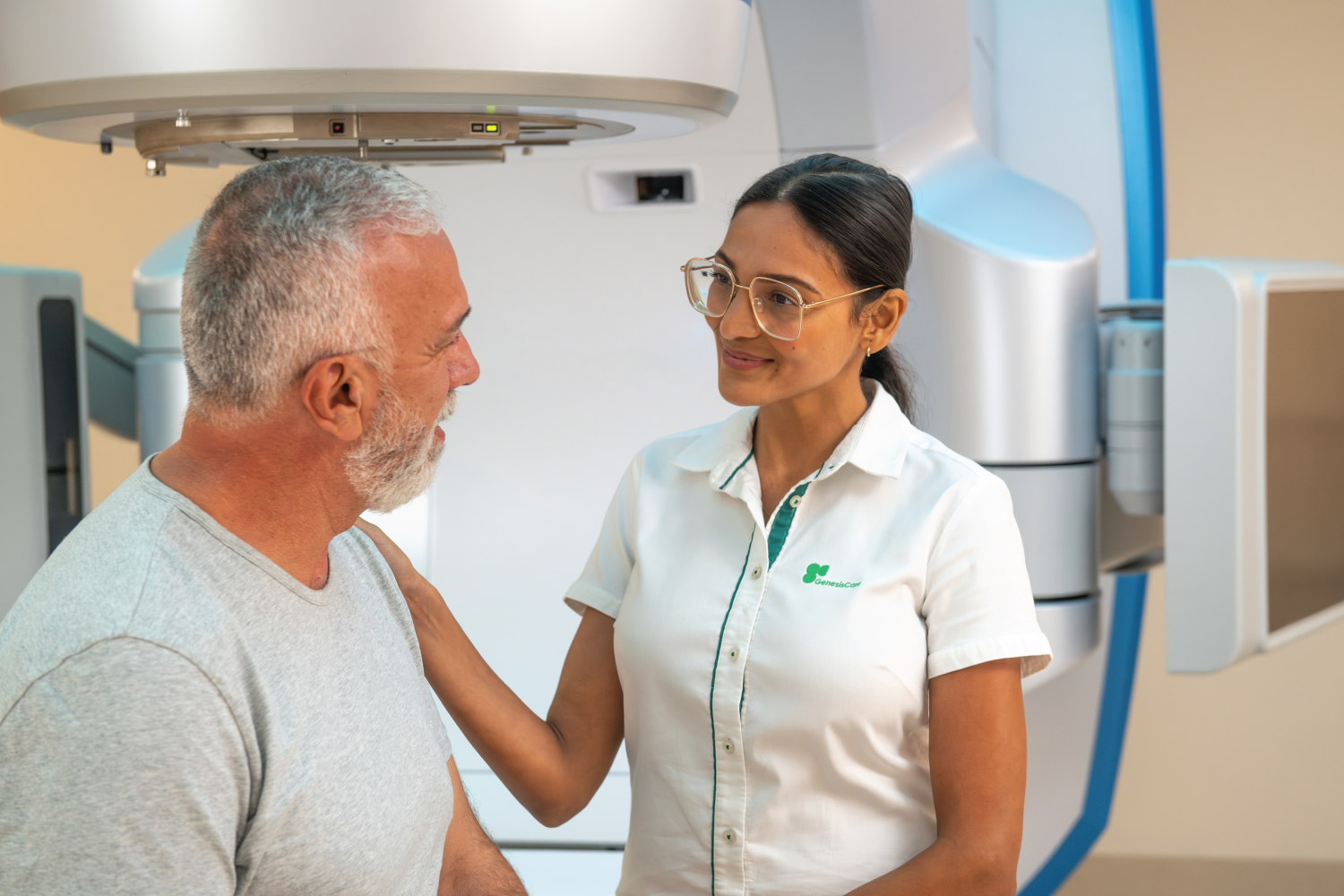Review Date: July 2025
Stereotactic Ablative Radiation Therapy (SABR), also known as Stereotactic Body Radiation Therapy (SBRT) is a short course, high dose of radiation therapy and may be an option for men with prostate cancer. SABR offers fewer treatment sessions than conformal radiation therapy, minimal toxicity, precision targeting, and potentially improved quality of life.
More on SABR
- It is a non-surgical treatment option
- Delivered in an outpatient setting, with no need for hospital stays
- Usually completed in five sessions1
- Delivered using advanced imaging techniques that allow real-time precision tracking of the tumour, minimising radiation to surrounding healthy tissue.2,3
SABR (also known as Stereotactic Body Radiotherapy or SBRT) delivers radiation with exceptional precision, enabling higher doses of radiation therapy to target the prostate. This treatment enables suitable patients with prostate cancer to be given more radiation to destroy cancer cells in fewer treatment sessions (compared to other types of radiation therapy).1,3 Usually prostate SABR is delivered over 5 treatments compared to 4-8 weeks of radiotherapy. Because SABR can be so precise, the treatment area may be smaller than conventional radiation treatment and most people have very few side effects.2
Who is SABR suitable for?
Your doctor is the best person to ask if SABR is appropriate for you. They will consider factors such as how active the cancer is, where it is located, the size of the prostate, any previous treatments such as a transurethral resection of the prostate, and your overall health.5
Radiation therapy (or Radiotherapy) uses high-energy X-rays, or other types of radiation, to treat cancer.4 The most common form is external beam radiation therapy (EBRT) where radiation is delivered from outside of your body.4 A large machine called a linear accelerator (or linac) is used to deliver external beam radiation therapy.4 Stereotactic radiation therapy (also called SABR, SBRT, SRS or SRT) is a way of delivering more radiation to your cancer, in fewer treatments using the same linac machine.3

- Your treatment visit will usually last around 30 minutes with machine beam-on time between only 5 to 10 minutes.
- Most of this time is to ensure you are positioned correctly and to perform final treatment checks
- You will need to consistently have a full bladder and empty bowel
- The radiation therapy itself is painless3 and the time that the radiation beam is on is relatively short
We’ll position you on the treatment bed in the same way we did during your CT (computed tomography) planning appointment. You may feel the treatment couch (bed) move slightly while you are being positioned.
- The radiation therapy team will leave the room while the radiation beams are switched on, but they will remain in contact with you through TV monitors and an intercom3
- You may hear a buzzing sound from the machine while it’s working, but there is nothing to see or feel - the radiation beams are invisible3
- The radiation machine will move around you during your treatment but will not touch you at any stage3
- During this treatment, real-time verification imaging of the prostate is performed to ensure millimetre-accurate delivery of treatment
- At the end of the treatment, the beam is turned off, and when you walk out of the room, there is no radiation in your body - this is just like having a diagnostic X-ray
Treatment centres
Search for a treatment centre near you

According to eviQ3, potential short-, mid- and long-term side effects include:
These may occur during treatment or within a few weeks of finishing radiation therapy. They usually settle within 4 weeks.
| Tiredness and lack of energy |
Tell your doctor or nurse if you have problems managing any of the symptoms listed above. |
| Bowel irritation |
- bowel motions (stools, poo) that are more urgent or frequent - a small amount of bleeding or clear discharge - a sore or irritated rectum - bloating, cramping or pain
Contact your doctor or nurse as soon as possible if your diarrhoea continues despite taking medication, or if you feel dizzy, light-headed or unwell. |
| Bladder problems |
Seek immediate medical attention from your doctor or nearest Emergency Department if you cannot pass urine or have severe discomfort. |
These may occur weeks to months after radiation therapy has finished.
| Bladder changes |
Radiation therapy can cause changes to the lining of your bladder which can be temporary or ongoing. You may have:
Tell your doctor or nurse if you get any of the symptoms listed above; they can help you to manage them. Seek immediate medical care if you cannot pass urine or have severe discomfort. |
These may develop months to years after radiation therapy has finished and may be permanent.
| Bowel changes |
For some people, their bowel habits do not return to normal after treatment has finished. You may get:
Tell your doctor or nurse if you get any of the symptoms listed above; they can help you to manage them. Contact your doctor or nurse as soon as possible if you have any bleeding from your rectum. |
| Bladder changes |
Radiation therapy can cause changes to the lining of your bladder which can be temporary or ongoing. You may have:
Tell your doctor or nurse if you get any of the symptoms listed above, they can help you to manage them. Contact your doctor or nurse immediately, or go to the nearest hospital Emergency Department if you cannot pass urine or have severe discomfort. |
| Sexual function and fertility |
|
| Developing a second cancer |
Talk to your doctor if you have any concerns about the benefits and risks of radiation therapy. |
Content reviewed by

Read next
- Parikh, N. R., & Kishan, A. U. (2020). Stereotactic body radiotherapy for prostate cancer. American Journal of Men's Health, 14(3), 1557988320927241.
- Chang, J. Y. (2015). Stereotactic ablative radiotherapy: aim for a cure of cancer. Annals of translational medicine, 3(1), 12.
- eviQ. (2024) Patient information. Prostate cancer. Stereotactic ablative radiation therapy (SABR). https://www.eviq.org.au/radiation-oncology/urogenital/prostate/4140-prostate-adenocarcinoma-definitive-ultra-hypo/patient-information (Accessed July 2025)
- Baskar, R., Lee, K. A., Yeo, R., & Yeoh, K. W. (2012). Cancer and radiation therapy: current advances and future directions. International journal of medical sciences, 9(3), 193.
- Targeting Cancer. (n.d.) Prostate Cancer Treatment in AU and NZ. https://www.targetingcancer.com.au/treatment-by-cancer-type/prostate-cancer/ (Accessed July 2025)

You are leaving our website
You are now leaving our website. GenesisCare do not control this content and therefore are not responsible for its accuracy or reliability.







